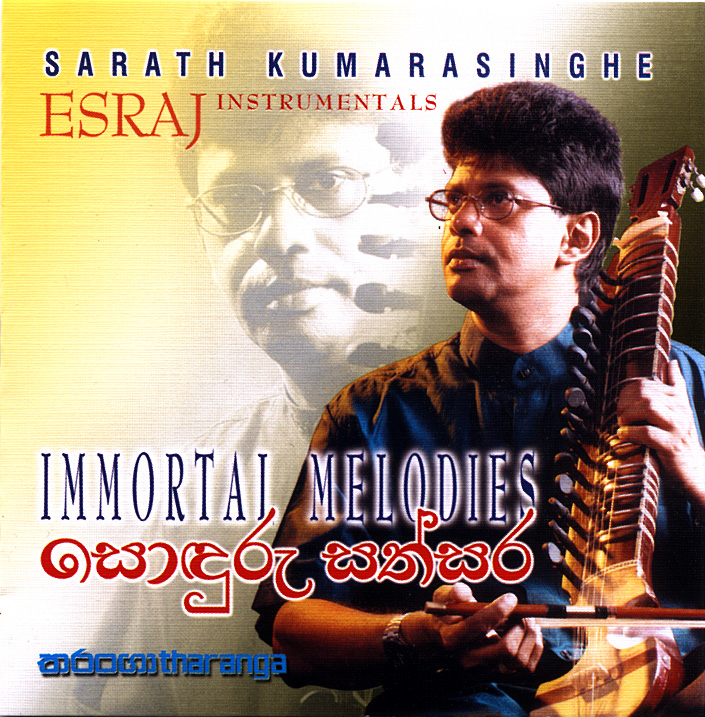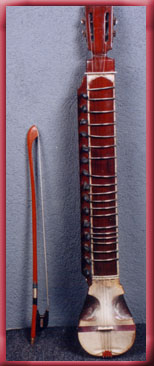 IMMORTAL MELODIES
IMMORTAL MELODIESEsraj Instrumental CD by Sarath Kumarasinghe
IMMORTAL MELODIES
DETAIL PAGE
|
About the CD |
|
All about Esraj |
|
About Sarath |
|
Song List |
|
Song Clips |
|
|
HOW TO ORDER
|
Sri Lanka |
|
North America |
|
Other countries |
|
Order Online |
|
|
LINKS
|
MP 3 site |
|
Real Audio |
|
Windows Media
|
| E mail Sarath |
|
|
The player and and his Instrument
- Like to listen to songs in the CD ? Download a song clip.
- Don't have a media player ? Download an MP3 player.
|
|
|
|
|
|
|
|
|
|
|
|
|
|
|
|
|
|
|
|
|
|
|
|
|
|
|
|
|
|
|
|
| About Sarath | All about Esraj | |

Sarath is an accomplished classical musician with a keen eye on improvisation. He commenced playing the instrument at the age of 12 years while in the secondary school. A product of Thurstan College, Colombo, he won the "best musical performer" prize for two consecutive years.
Under the guidance of Visharad H.de S.Jayasekera, Sarath nurtured his vocal and instrumental classical music skills from the Bhatkande Music University in Lucknow, India.
His first solo Esraj instrumental recording of six sinhala and hindi songs was telecasted by the Independent Television Network of Sri Lanka (ITN) in the year 2000, which inspired the light music listners and the musicians in the country alike due to his soothing style of play and the uniqueness of the tone of this hitherto classical instrument.
Sarath has participated in numerous recordings and performed on radio, television and stage performances on classical and light music. Sarath plays his Esraj in Dr.Lester James Pieris' latest film, "Wekande Walawwa" where Pradeep Ratnayake, the young sitar maestro directed the musical score.
|
The shape of the instrument resembles a smaller version of the well known insrument, the Sitar. The fretboard and fret placingss of the instrument are identical to that of the Sitar. However, the similarity almost ends there.
The Esraj is a string instrument played with a bow. The instrument has four main strings and fifteen vibration strings. Only the first (and occasionally the second) strings are played. Other strings provide a rich vibration effect making a fuller and deep, soothing tone.
Unlike the Sitar which has a bottom part which is hard, the Esraj has a leather covering at the bottom similar to that of a Banjo with a bridge which keeps the strings together. The bowing is done just above the bridge, as in violins and violas. The Esraj is played in a sitting position with the bottom part of the instrument (where bowing is done) resting on the lap of the player.
There are two major playing styles of this instrument. In the Bhatkhande style, the top part of the instrument rests against the left shoulder of the player while playing, whereas in the Shanthiniketan style, the instrument is held on a freestanding ninety degree vertical posture.
|
| About the CD | Acknowledgements | About Esraj | About Sarath | Song List | How to Order | Song Clips | Home |
|
|
|
|
|
|
|
|
|
|
|
|
Page last updated December 26, 2003.
 Esraj (Esraaj) is an instrument with a recorded history of several centuries. With its'
origin in India, the instrument is predominantly used as an accompaniment for classical
music singers and musicians.
Esraj (Esraaj) is an instrument with a recorded history of several centuries. With its'
origin in India, the instrument is predominantly used as an accompaniment for classical
music singers and musicians.